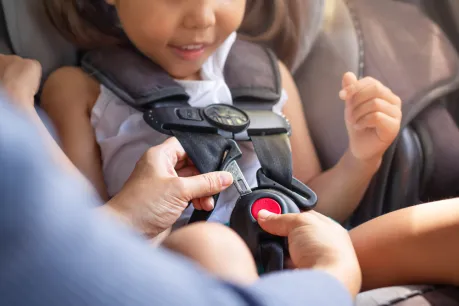Why Wearing a Seat Belt Saves Lives: Key Facts and Misconceptions

Injured?
Be their hero behind the wheel. Hear John Morgan’s powerful message on safe driving—click here to watch.
As your child’s hero, you not only lead the way, but you demonstrate how the journey should go.
In the car, that means making sure your family is safely fastened in and setting a great example by buckling up yourself.
While it’s not exactly new tech, having made its vehicular debut in the 1950s, the seat belt continues to be one of the most important and life-saving features in your car. So, why are some people still hesitant to buckle up? Let’s explore the facts, bust some myths, and explain why wearing a seat belt is more than just a suggestion—it’s your superpower on the road.
The Superpower of Seat Belts: Key Facts
Here’s the deal: seat belts save lives. Period. In fact, according to the National Highway Traffic Safety Administration (NHTSA):
- Seat belts reduce the risk of death by 45% for front-seat passengers in a car.
- Wearing a seat belt can lower the risk of serious injury by 50%.
- In 2020, seat belts saved an estimated 14,955 lives in the U.S. alone.
The numbers don’t lie. Whether you're making a quick trip to the grocery store or embarking on a cross-country road trip, that simple act of buckling up drastically increases your chances of survival in an accident.
Busting Myths: Why Some People Don’t Buckle Up
Despite all the overwhelming evidence, not everyone wears a seat belt. Why? Some of the lack of seatbelt safety could be due to a lot of misconceptions floating around. Let’s take a closer look at some of these myths—and set the record straight.
Myth #1: “I’m just going down the street. I don’t need a seat belt for short trips.”
Reality: Most car accidents happen close to home, with 52% of crashes occurring within a 5-mile radius of a person’s residence. That “quick trip” to the store can turn into an accident in the blink of an eye. So, whether you’re driving to the mailbox or across the state, seat belts are non-negotiable.
Myth #2: “Seat belts are more likely to cause injuries than prevent them.”
Reality: Seat belts are incredibly effective at keeping people in their seats during an impact or rollover. Still, impact with the seat belt itself can lead to a cluster of injuries often called seat belt syndrome. While it is true that seat belts themselves can cause injuries during a car accident, the severity of these injuries usually pales in comparison to the frequently fatal injuries caused by not wearing a seat belt at all—in particular, severe trauma to the head, chest, and abdomen.
Myth #3: “My airbag will do the trick.”
Reality: While airbags are incredibly effective, they are meant to be used in conjunction with seat belts, not as a replacement for proper seat belt safety.
In fact, when someone is not wearing a seat belt, airbags may have the opposite effect. Those who are unrestrained or improperly restrained have a higher risk of suffering spinal injuries or traumatic brain injuries from hitting the airbag.
Myth #4: “I’ll just brace myself if I see an accident coming.”
Reality: Sorry to break it to you, but no human has the reflexes to brace themselves in time for a crash. In a head-on collision at 30 mph, you’d be thrown forward with the force of 3,000 pounds. There’s no amount of arm strength that can protect you from that kind of impact. Your seat belt, however, can.
The Family Factor: Setting the Example
Now, let’s bring it back to the most important reason you should always wear a seat belt—your family. Remember, your kids are always watching. They see how you handle your car, from the way you use your turn signals to whether or not you buckle up. When you make seat belts a non-negotiable habit, you're teaching them a lesson that could one day save their lives.
Not to mention, seat belts are required for everyone in the car—not just the driver. A child can’t physically buckle up for themselves if they’re too young, so it’s up to you to make sure everyone is safely secured before the wheels start rolling. And trust us, when you make it a routine, they’ll start buckling up on their own in no time.
Still Essential Today: Seat Belts in a Modern World
With all the new high-tech safety features in cars today, like lane assist and automatic emergency braking, you might wonder: Are seat belts still necessary? The answer is a resounding YES.
No matter how advanced our cars become, seat belts are your first line of defense in any crash. They work in tandem with airbags, but only if you’re properly restrained. In fact, without a seat belt, an airbag can actually do more harm than good, causing injuries from the force of the airbag’s deployment.
In short, seat belts are essential in today’s cars—and they always will be. No amount of technology can replace the basic protection they provide.
Be Their Hero: Buckle Up Every Time
At the end of the day, being a hero doesn’t require a cape or superpowers—it just requires making smart, safe choices. Wearing a seat belt is one of the easiest ways to protect yourself and your loved ones, and it sets the right example for the next generation of drivers. So, buckle up, be safe, and be the hero your kids already think you are.
Morgan & Morgan Is Here to Help
If you or a loved one has been injured in a car accident, we’re ready to fight for you. Our experienced team can help you get the compensation and justice you deserve. Contact us today for a free case evaluation.
Learn more

We've got your back
Injured?
Not sure what to do next?
We'll guide you through everything you need to know.

